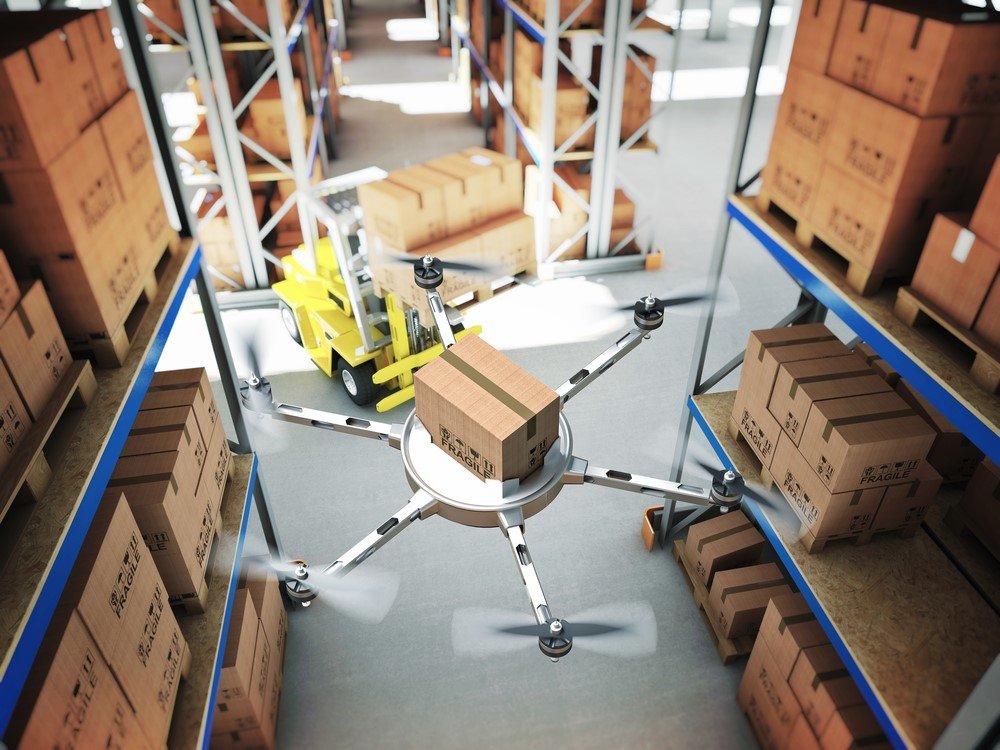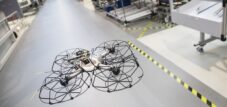
Drone in the warehouse: In the future it will also be controlled using VR glasses (Source: Shutterstock)
Use of flying helpers in logistics and production
Whether for controlling and inspecting flows of goods and systems or for making deliveries; The benefits of using drones for industrial and logistical purposes are now widely recognized. Most of the time, however, the transport of goods over land is examined and less attention is paid to the possible uses in storage or production facilities. Drones are just as suitable for use inside buildings. Only the control of the aircraft is sometimes a little more complex in rooms.
Thanks to rapidly advancing technical developments, drones of all sizes are available for a wide range of applications. Despite their small dimensions, even small devices now have sufficient load capacity to transport objects or be equipped with high-resolution cameras and scanning technology.
Their agile flight characteristics enable drones to operate in confined spaces, which is why they are well suited for use in warehouses and production halls. Your advantage: While there is usually a lot of traffic on the floor of a warehouse or assembly hall, the air space above is largely free. It makes sense to use this to quickly deliver items to the assembly line or shipping station via drone.
Controlling the drones
In general, it is easier to program routes for drones' sometimes long cross-country flights than to specify routes through narrow corridors in warehouses or assembly halls, where the terrain is more complex and the risk of collisions is significantly greater. DHL 's various tests with the parcel copter are just one example of many. In the future, outdoor flights will primarily be controlled automatically using high-performance software. This shows the drones the most efficient tasks and routes and ensures that the small transporters do not collide with each other, other objects or even people. However, this technology still has its pitfalls, especially when unforeseen situations arise or complicated orders are involved. However, these are the general conditions that prevail in industrially used rooms. When it comes to transporting sensitive parts worth several thousand euros, companies prefer to play it safe and leave the controls to a pilot.
The times in which drones are controlled with the help of the classic console are slowly but surely coming to an end. Instead of a clunky controller, the aircraft can now also be piloted with smartphones or tablets. The commands are triggered by tilting, rotating and tilting the mobile handheld, which are sent to the drone via an app and WiFi or Bluetooth connection.
Flight via virtual reality
As an alternative to smartphone or tablet control, drones can also be flown using VR glasses . The commands are given in a similar way to mobile devices: If the pilot tilts in one direction, the drone flies in the same direction; if the head is tilted forward or backward, the drone also follows the movement. When the pilot turns, the drone turns accordingly.
, compared to smartphones etc., a more detailed flight can be carried out using VR glasses because the pilot controls the drone from the first person perspective. Instead of the virtual world, the glasses capture the signal from a camera mounted on the front of the drone, which transmits the camera image to it in real time. This gives the pilot an extremely authentic flight experience; almost as if he was sitting directly in the cockpit of the drone. This realistic overview allows the pilot to control the drone extremely precisely and to react quickly to unforeseen situations. The latter in particular is not always the case, despite all the high-tech and rapid technological development in software-controlled models.
Hybrid solutions are also conceivable for complex tasks, in which the drone automatically flies to the destination and the pilot takes over from there. In this case, manual use is limited to necessary activities, saving working time while ensuring that the complex tasks are carried out by an expert, while the routine flight can be taken over by the software. One goal will be to coordinate drones even better with each other and their human partners in the future in order to achieve even more effective results.
Use of drones in production and warehouse
Drones are suitable for various tasks in buildings, such as inventory . Normally, inventory levels are checked and counted manually by employees. However, if downtime is to be minimized, this task must be carried out in parallel with day-to-day business. Often this is only possible in the form of overtime outside of normal business hours - with productivity-reducing factors such as overtime pay and the risk of increasing inaccuracy due to staff fatigue. Not least for these reasons, the US retail giant Walmart is already carrying out inventory checks using drones .
With the help of drones, the inventory process can be automated and therefore also carried out at night or on weekends. During their flights, the devices record the existing stocks by camera and scanner, at the same time check the inventory and report the results directly to the inventory system. A system specially specialized in the implementation of inventories was developed by Linde Material Handling together with the French automation expert Balyo . The so -called “Flybox” is intended to simplify inventory processes so that companies save valuable time and costs. The drone equipped with camera and barcode scanner can work completely automatically and enable an inventory outside of regular working hours.
Drones are also well suited to supporting production processes, for example for the internal transport of spare parts . In order to reduce machine idle times and production downtimes to a minimum, speed is particularly important. The quick and efficient transport of spare parts by drone within large factories helps to successfully overcome this challenge. Where people or AGVs quickly lose track of things or have to endure long journeys, the intelligent transport systems fly directly to the sought-after parts and take them to where they are needed as quickly as possible.
The car manufacturer Audi is using drones as a test at its Ingolstadt factory . The possibility of automated drone transport of parts to the assembly lines is being tested there during ongoing operations. The starting point for the consideration was the faster delivery via direct air transport compared to ground-based conveyor vehicles. If such tests are successful, there will be little standing in the way of a wider introduction of drones in industry in the future.

